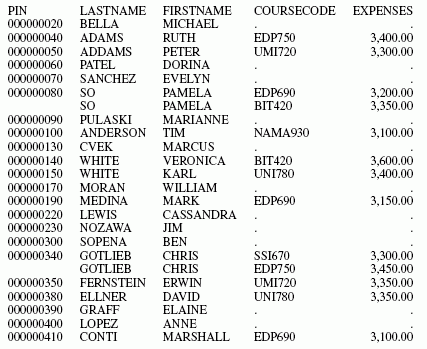|
In this section: |
In multi-segment data sources, when an instance in a parent segment does not have descendant instances, the nonexistent descendant instances are called missing instances.
When you write a request from a data source that has missing segment instances, the missing instances affect the report. For example, if the request names fields in a segment and its descendants, the report omits parent segment instances that have no descendants. It makes no difference whether fields are display fields or sort fields.
When an instance is missing descendants in a child segment, the instance, its parent, the parent of its parent, and so on up to the root segment, is called a short path. Unique segments are never considered to be missing.
For example, consider the following subset of the EMPLOYEE data source.
- The top segment contains employee names.
- The left segment contains addresses.
- The right segment
contains the salary history of each employee: the date the employee
was granted a new salary, and the amount of the salary.

Suppose some employees are paid by an outside agency. None of these employees have a company salary history. Instances referring to these employees in the salary history segment are missing.
Nonexistent descendant instances affect whether parent segment instances are included in report results. The SET ALL parameter and the ALL. prefix enable you to include parent segment data in reports.
For illustrations of how missing segment instances impact reporting, see Reporting Against Segments Without Descendant Instances and Reporting Against Segments With Descendant Instances.
Example: Reporting Against Segments Without Descendant Instances
The following request displays the salary histories for each employee.
TABLE FILE EMPLOYEE PRINT SALARY BY LAST_NAME BY FIRST_NAME BY DAT_INC END
However, two employees, Davis and Gardner, are omitted from the following report because the LAST_NAME and FIRST_NAME fields belong to the root segment, and the DAT_INC and SALARY fields belong to the descendant salary history segment. Since Davis and Gardner have no descendant instances in the salary history segment, they are omitted from the report.
The output is:
LAST_NAME FIRST_NAME DAT_INC SALARY
--------- ---------- ------- ------
BANNING JOHN 82/08/01 $29,700.00
BLACKWOOD ROSEMARIE 82/04/01 $21,780.00
CROSS BARBARA 81/11/02 $25,775.00
82/04/09 $27,062.00
GREENSPAN MARY 82/04/01 $8,650.00
82/06/11 $9,000.00
IRVING JOAN 82/01/04 $24,420.00
82/05/14 $26,862.00
JONES DIANE 82/05/01 $17,750.00
82/06/01 $18,480.00
MCCOY JOHN 82/01/01 $18,480.00
MCKNIGHT ROGER 82/02/02 $15,000.00
82/05/14 $16,100.00
ROMANS ANTHONY 82/07/01 $21,120.00
SMITH MARY 82/01/01 $13,200.00
RICHARD 82/01/04 $9,050.00
82/05/14 $9,500.00
STEVENS ALFRED 81/01/01 $10,000.00
82/01/01 $11,000.00Example: Reporting Against Segments With Descendant Instances
The following request displays the course codes and expenses for employees in the EMPDATA and TRAIN2 data sources. The report output displays all employees that have instances in the COURSECODE or EXPENSES fields. The employees that are missing instances for either of those fields are omitted from the report. For those employees that have instances for only one of the fields, the designator for missing data displays in the respective column. In this example, Henry Chisolm has taken two courses but only has expenses for one. Therefore, the designator for missing instances displays in the EXPENSES column.
JOIN EMPDATA.PIN IN EMPDATA TO ALL TRAINING.PIN IN TRAIN2 AS JOIN1 TABLE FILE EMPDATA PRINT LASTNAME AND FIRSTNAME AND COURSECODE AND EXPENSES BY PIN END
The output is:
PIN |
LASTNAME |
FIRSTNAME |
COURSECODE |
EXPENSES |
000000010 |
VALINO |
DANIEL |
PDR740 |
2,300.00 |
000000030 |
CASSANOVA |
LOIS |
NAMA730 |
2,600.00 |
CASSANOVA |
LOIS |
EDP090 |
2,300.00 |
|
. . . |
||||
000000350 |
FERNSTEIN |
ERWIN |
SSI220 |
1,850.00 |
FERNSTEIN |
ERWIN |
MC90 |
1,730.00 |
|
FERNSTEIN |
ERWIN |
UMI720 |
3,350.00 |
|
000000360 |
CHISOLM |
HENRY |
EDP090 |
.00 |
CHISOLM |
HENRY |
EDP690 |
3,000.00 |
|
000000370 |
WANG |
JOHN |
UMI710 |
2,050.00 |
000000380 |
ELLNER |
DAVID |
EDP090 |
. |
ELLNER |
DAVID |
UNI780 |
3,350.00 |
|
000000410 |
CONTI |
MARSHALL |
EDP690 |
3,100.00 |
Note: The report output has been truncated for demonstration purposes.
